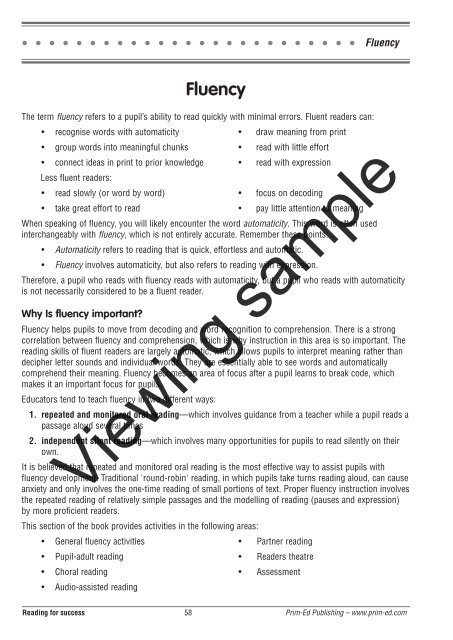PR-6218IRE Reading for Success - Book 3
You also want an ePaper? Increase the reach of your titles
YUMPU automatically turns print PDFs into web optimized ePapers that Google loves.
Fluency<br />
Fluency<br />
The term fluency refers to a pupil’s ability to read quickly with minimal errors. Fluent readers can:<br />
• recognise words with automaticity • draw meaning from print<br />
• group words into meaningful chunks • read with little ef<strong>for</strong>t<br />
• connect ideas in print to prior knowledge • read with expression<br />
Less fluent readers:<br />
• read slowly (or word by word) • focus on decoding<br />
• take great ef<strong>for</strong>t to read • pay little attention to meaning<br />
When speaking of fluency, you will likely encounter the word automaticity. This word is often used<br />
interchangeably with fluency, which is not entirely accurate. Remember these points:<br />
• Automaticity refers to reading that is quick, ef<strong>for</strong>tless and automatic.<br />
• Fluency involves automaticity, but also refers to reading with expression.<br />
There<strong>for</strong>e, a pupil who reads with fluency reads with automaticity, but a pupil who reads with automaticity<br />
is not necessarily considered to be a fluent reader.<br />
Why Is fluency important?<br />
Fluency helps pupils to move from decoding and word recognition to comprehension. There is a strong<br />
correlation between fluency and comprehension, which is why instruction in this area is so important. The<br />
reading skills of fluent readers are largely automatic, which allows pupils to interpret meaning rather than<br />
decipher letter sounds and individual words. They are essentially able to see words and automatically<br />
comprehend their meaning. Fluency becomes an area of focus after a pupil learns to break code, which<br />
makes it an important focus <strong>for</strong> pupils.<br />
Educators tend to teach fluency in two different ways:<br />
1. repeated and monitored oral reading—which involves guidance from a teacher while a pupil reads a<br />
passage aloud several times<br />
2. independent silent reading—which involves many opportunities <strong>for</strong> pupils to read silently on their<br />
own.<br />
It is believed that repeated and monitored oral reading is the most effective way to assist pupils with<br />
fluency development. Traditional 'round-robin' reading, in which pupils take turns reading aloud, can cause<br />
anxiety and only involves the one-time reading of small portions of text. Proper fluency instruction involves<br />
the repeated reading of relatively simple passages and the modelling of reading (pauses and expression)<br />
by more proficient readers.<br />
This section of the book provides activities in the following areas:<br />
• General fluency activities • Partner reading<br />
• Pupil-adult reading • Readers theatre<br />
• Choral reading • Assessment<br />
• Audio-assisted reading<br />
Viewing sample<br />
<strong>Reading</strong> <strong>for</strong> success 58 Prim-Ed Publishing – www.prim-ed.com


















